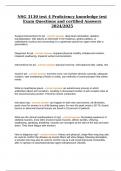NSG 3130 test 4 Proficiency knowledge test
Exam Questions and certified Answers
2024/2025
Surgical interventions for pd - correct answer deep brain stimulation, ablation,
transplantation. Dbs places an electrode in the thalamus, globus pallidus, or
subthalamic nucleus and connecting it to a generator placed on upper chest (like a
pacemaker)
Diagnoses for pd - correct answer impaired physical mobility, imbalanced nutrition,
impaired swallowing, impaired verbal communication
Interventions for pd - correct answer physical exercise, well balanced diet, safety, rest
Goal for pd - correct answer exercise more, use assistive devices correctly, adequate
nutrition, safe swallowing of fluids or solids, use methods of communication that meets
needs
What is myasthenia gravis - correct answer an autoimmune process in which
antibodies attach ach receptors, resulting in decreased number of ach receptor sites at
the neuromuscular junction. Prevents muscle contraction.
Info about mg - correct answer can happen in both men and women, all ethnicities,
peak onset for women is in child bearing years, for men the peak onset is 50-70, thymic
tumors or abnormal thyroid tissues are found in 15 percent of patients
What are the clinical manifestations of mg? - correct answer fluctuating weakness of
skeletal muscles, most often involves facial muscles, affects eyelids, chewing,
swallowing, speaking, breathing- muscles are strongest at the start of the day and wear
down. They have fatigue with exertion.
How to diagnose mg? - correct answer history and physical, single-fiber emg may also
be used to confirm the disease as muscle fibers will show fatigue following stimulation,
a tensilon test may also be used to confirm mg as it will reveal improved contractility
after iv injection of anticholinesterase agent edrophonium chloride.
,Treatment options for mg - correct answer anticholinesterase drugs- increase the
function of neuromusclular junctions and prolongs the action of ach and facilitate
transmission, immunosuppresive therapies to avoid cholinergic or myasthenic crisis,
plasmapheresis or ivig- when you cannot use corticosteroids, thymectomy- for all
patients with thymoma, pyridostigmine (most effective for long term), neostigmine,
prednisone- corticosteroids, immune response drugs (azathioprine, mycophenolate, and
cyclosporine)
Why do patients with mg have a thymectomy? - correct answer removing the thymus
decreases the production of achr antibodies
What can lead to an mg exacerbation? - correct answer emotional stress, pregnancy,
trauma, temp extremes, illness, hypokalemia
Nursing problems for mg - correct answer ineffective airway rt muscle weakness and
impaired gag reflex, impaired verbal communication rt weakness, activity intolerance
due to muscle weakness and fatigue, disturbed body image when they can't keep same
lifestyle or work as much.
Outcomes and teaching for mg - correct answer maintain adequate ventilation,
continuing drug treatment with timing so that dose peaks at meal times, monitor for s/s
of cholinergic crisis and myasthenic crisis, focus care on neurological deficits and
impact of adls, plan activities to avoid fatigue, educate them to balance their diet to be
easily chewed and swallowed, educate on complications of disease such as drug
toxicity, educate on how to handle crisis situations
Myasthenic crisis - correct answer acute exacerbation of muscle weakness triggered
by infection, surgery, stress, drug overdose, or not enough of drugs. Know s/s of
aspiration, respiratory insufficiency, resp. Tract infection- they will have improved
strength with anticholinesterase drugs
Cholinergic crisis - correct answer overdose of anticholinesterase drugs leading to
increased ach at receptor sites. Weakness within one hour of admin anticholinesterase
treatment, s/s increased weakness of skeletal muscles such as ptosis (droopy eye lid),
bulbar sign (chewing weakness), dyspnea, smooth muscle effects including pupillary
miosis, salivation, diarrhea, n/v, abdominal cramps, increased bronchial secretions,
lacrimation
, What is als? - correct answer a rare progressive disorder that interferes with the body's
ability to use its muscles, there is no cure but patients may live up to ten years after the
diagnosis
How common is als and who gets it - correct answer men are twice as likely to get it
than women, usually from 40 to 70
Things to tell patients who get diagnosed with als - correct answer they usually live 2-6
years but they can live for more than ten, they will not lose their minds, riluzole tx can
slow the progression but there is no cure, they need a well-balanced program of rest
and moderate exercise
Some tests that can help diagnose als - correct answer specific biomarkers in the csf,
nerve conduction velocity tests, testing muscle response to electrical stimulation- rule
out other dx that mimics als
Roles of treatment - correct answer pt- maintain optimal muscle functions
Ot-maintian adls
St- maintain verbal communication
Rd- maintain balanced diet when chewing and swallowing become difficult
Rt- maintain a clear airway
Psych- maintain positive body image and grieving process r/t loss of muscle function
Best way to talk about the end with patients who have als - correct answer describe
that the lack of being able to use their respiratory muscles to breathe, and it will
ultimately lead to death but having an advanced directive will ensure autonomy
What is trigeminal neuralgia? - correct answer chronic irritation of the trigeminal nerve
at root entry zone by compression of the superior cerebellar artery, makes them have
facial spasms, pain, paroxysms (shock in lips, upper and lower gum pain, twitching,
grimacing, frequent blinking, tearing up of eyes)
What puts patients at risk for trigeminal neuralgia? - correct answer ms, htn, teeth
infections, jaw or brainstem infections




